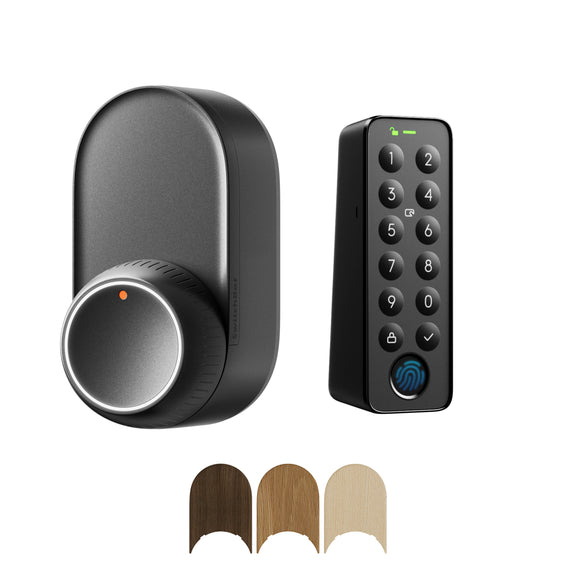Unlocking Security: Why Your Next Deadbolt Should Be Fingerprint Activated!
In an era where technology continuously evolves to enhance our daily lives, the rise of fingerprint deadbolt locks has become a game changer in home security. Gone are the days when we relied solely on traditional keys to secure our homes. As convenience merges with safety, fingerprint locks have gained traction among homeowners seeking advanced security solutions. The necessity for robust security measures has never been more pronounced, especially with increasing concerns over theft and unauthorized access. Imagine entering your home with just a touch of your finger, eliminating the fumbling for keys while ensuring that only authorized individuals can gain entry. This innovative approach not only simplifies access but also enhances peace of mind, making fingerprint deadbolt locks an essential consideration for modern security.

Understanding Fingerprint Deadbolt Locks
A fingerprint deadbolt lock is a sophisticated locking mechanism that utilizes biometric technology to grant entry based on the unique characteristics of an individual's fingerprint. At its core, the lock is equipped with a scanner that captures and analyzes fingerprint patterns, distinguishing them from unauthorized users. When a registered fingerprint is scanned, the lock quickly verifies the identity and, if matched, disengages the bolt to allow entry. This technology works through algorithms that convert the fingerprint into a digital format, which is then stored securely in the device. The benefits of using biometrics for security are profound; they offer a level of precision and personalization that traditional keys cannot match. Not only do they reduce the risk of unauthorized access, but they also eliminate the hassle of lost keys, making them a popular choice among homeowners.
Benefits of Fingerprint Deadbolt Locks
The advantages of fingerprint deadbolt locks are plentiful and persuasive. For one, they significantly enhance security by ensuring that only registered fingerprints can unlock the door. This feature is particularly beneficial for families, as parents can easily add or remove fingerprints for children or visitors without the need for spare keys. Convenience is another major draw; no more fumbling through bags or pockets for keys, especially when your hands are full. Moreover, most fingerprint deadbolt locks allow multiple fingerprints to be stored, accommodating various users seamlessly. Another standout benefit is the peace of mind that comes from knowing your home is safeguarded with cutting-edge technology. The ability to monitor access and receive alerts when someone enters or exits can provide an extra layer of protection, making fingerprint deadbolts an attractive option for the security-conscious homeowner.
Considerations When Choosing a Fingerprint Deadbolt Lock
When selecting a fingerprint deadbolt lock, several key factors warrant careful consideration to ensure you make the right choice for your home. First, battery life is crucial, as many fingerprint locks run on batteries and can potentially fail if not regularly maintained. Look for models with longer battery life and consider those with low-battery alerts to avoid unexpected lockouts. Durability should also be a priority; choose locks made from high-quality materials that can withstand weather elements and wear over time. Installation requirements can vary, so it's essential to assess whether you are comfortable with DIY installation or would prefer professional help. Lastly, consider the fingerprint storage capacity—some locks can store dozens of fingerprints, while others may only allow a handful. This feature can significantly impact your decision depending on your household size and guest access needs.
Installation and Maintenance Tips
Installing a fingerprint deadbolt lock can be a straightforward process if you follow the manufacturer's guidelines. Begin by removing your old deadbolt and preparing the door for the new lock. Ensure that the holes are correctly aligned for a seamless installation. Once installed, it’s vital to regularly maintain the lock to ensure its longevity and performance. Keep the fingerprint scanner clean and free from debris, as dirt can interfere with the recognition process. Regularly check the battery and replace it as needed to avoid any disruptions. Additionally, familiarizing yourself with the programming features will help you efficiently manage user access and troubleshoot any issues that may arise.
Common Misconceptions
Despite their growing popularity, fingerprint deadbolt locks are often surrounded by misconceptions. One common myth is that they are unreliable, which can stem from outdated technology. Modern fingerprint locks are equipped with advanced algorithms that significantly reduce error rates. Another concern is vulnerability to hacking; while no system is entirely immune, the biometric security offered by these locks is generally more robust than traditional keys. Many individuals also worry about the effectiveness of biometrics in varying conditions, such as wet or dirty fingers. However, most locks are designed to function in diverse environments and can still read fingerprints effectively. Addressing these misconceptions is essential for potential buyers to make informed decisions about enhancing their home security.
Key Takeaways on Fingerprint Security
In summary, fingerprint deadbolt locks represent a significant advancement in home security technology, blending convenience with enhanced protection. By understanding how these locks work and the benefits they offer, you are better equipped to consider them for your home. From improved access management to the elimination of forgotten keys, the advantages are clear. As security continues to be a priority for homeowners, investing in a fingerprint deadbolt lock is a proactive step towards safeguarding your home. Explore the various options available, weigh the considerations outlined in this article, and make an informed decision that enhances your peace of mind.
